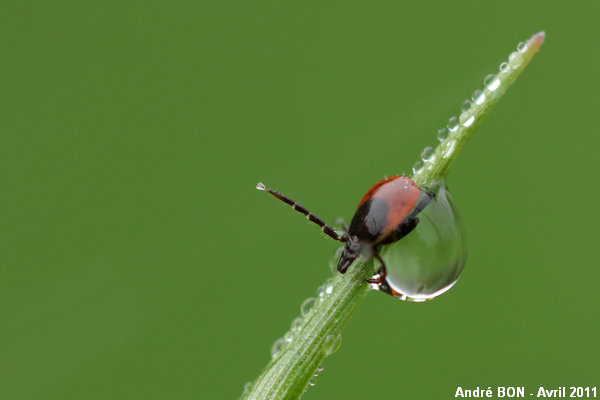

| Sheep Tick (Ixodes ricinus (Linnaeus, 1758)) |


|
|
Scientific name: Ixodes ricinus (Linnaeus, 1758) Common name: Sheep Tick Other names: Castor Bean Tick French name: Tique du mouton Order: Ixodida Family: Ixodidae Size: Males: 2,4 to 2, 8 mm long; Females: 3 to 3,6 mm long and up to 11 mm long when engorged with blood. Biotope: Meadows, forests, heathlands suitable for host species. The Sheep Tick requires humidity, that's why it prefers damp areas and is missing in dry places. Web: No web. Observation period: The life cycle generally lasts 3 years (up to 6 in difficult conditions). The main activity period is between March and October, with a peak in spring and a another less important peak in autumn. Geographic area: Europe, Middle-East, North Africa. |
Ticks are bloodsucking parasite acari. There are 41 different species in France. Ticks of the Ixodidae family are characterized by a hard shield on their back (so they are called hard-bodied ticks) and by an elongated forward roster. The life cycle has 4 stages. Larvae which live very close to the ground (up to 15 cm high), will parasite small animal during two or three days and will fall back on the ground to nymphate. Larvae have only three pairs of legs. You can find nymphs up to 50 cm above the ground. They parasite the same species as larvae, but during a longer time, from five to six days. Ticks have four pairs of legs since the nymph stage. You can recognize male adult ticks by their hard shield, or scutum, completely covering their back. It is only covering one half on a non engorged female. Mating occurs during the free phase or on a host animal. Females parasite large size animals during seven to ten days. They lay up to 5000 eggs and will die just after that. Telling ixodidae species apart is difficult and you need a close morphologic examination with a binocular microscope (15 species of the Ixodes genus have been observed in western Europe). Let's also mention the Hedgehog Tick (Pholeoixodes hexagonus) whose hard shield or scutum reaches his maximum width in the middle and then suddenly tapers off. It is a more regular oval shape on the Sheep Tick. Let's mention the Brown Dog Tick (Rhipicephalus sanguineus) - Pay attention that the Sheep Tick also parasites dogs - whose base of the capituli is hexagonal-shaped when seen from above. The overall colour is more uniform brown-reddish. There is a spur at the base of the fore legs. It is rather found in hot and dry regions. The Fox Tick (Ixodes canisuga) has an oval shaped hard shield but thinner at the rear compared to the Sheep Tick. The Ornate Cow Tick, Dermacentor reticulatus, has a rounded roster and its hard shield shows white marks. Ticks carry germs which are vectors of many diseases, including the Lyme disease. So you need to take precautions. The first one is to wear closed shoes and trousers in the areas where ticks are present. The second is to use specific tick hooks to remove ticks so that they do not expulse toxins. |
| [To know more about the Sheep Tick] [Next picture] [Top] |

|
I am now much more careful since this observation in the forest. We are exposed to ticks during our naturalist photo sessions and I am now always wearing trousers and closed shoes. There are many Western Roe Deer's in this area and this Sheep Tick will certainly not have to wait for a very long time before attaching to a host mammal. |
| [To know more about the Sheep Tick] [Previous picture] [Top] |

|
Sheep Tick waiting for a host in morning dew. |